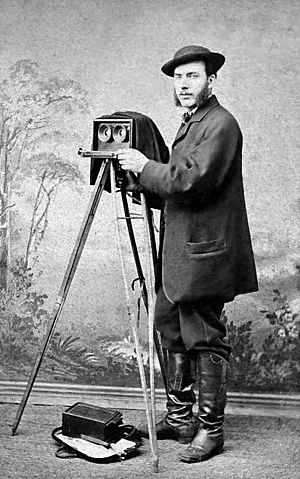John Carbutt facts for kids
John Carbutt (born 1832, died 1905) was a very important person in the early days of photography. He was a pioneer, meaning he was one of the first to do new things in this field. He published many stereo cards, which were like early 3D pictures. He was also a smart businessman in photography. John Carbutt was the first to use a material called celluloid for photographic film. He also helped sell dry-plate glass negatives, which made photography much easier.
He was born in Sheffield, England, on December 2, 1832. Later, in 1853, he moved across the ocean to Chicago in the United States.
Contents
Photography and Railroads
In 1866, John Carbutt worked as the official photographer for the Union Pacific Railroad. This was a big job! He took many pictures for a series of stereo cards called Rail Road Excursion to the 100th Meridian. These cards celebrated a special moment in October 1866. This was when the railroad crossed the border between the western and eastern parts of the United States. This crossing was a key step in building the first transcontinental railroad.
Making Film History
Inventing Celluloid Film
John Carbutt started his own company, the Keystone Dry Plate Works, in 1879. He made a huge breakthrough in 1888. He was the first to create sheets of celluloid that were covered with a special photographic emulsion. This was a big step towards making celluloid film as we know it.
Carbutt would cut thin pieces from a solid block of celluloid. Then, he would coat these pieces with a silver gelatin emulsion. This created what he called a Celluloid Dry Plate.
The 35mm Standard
Around 1890, Carbutt made these film sheets in a 35 mm width. This size was perfect for William Kennedy Dickson's Kinetoscope. The Kinetoscope was an early device for showing moving pictures. This 35 mm width became the standard size for movie cameras and still cameras.
Even today, this image size is very important. Many high-end digital cameras use a sensor that is the size of a 35mm film frame. Also, some photographers and filmmakers still use 35mm film for their work.
Later Life
John Carbutt is buried at West Laurel Hill Cemetery. This cemetery is located in Bala Cynwyd, Pennsylvania.
See also


